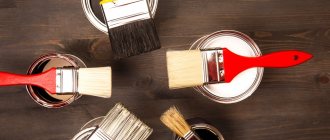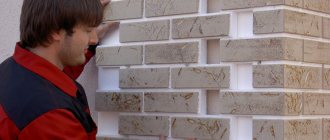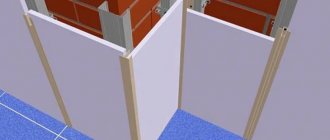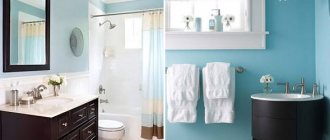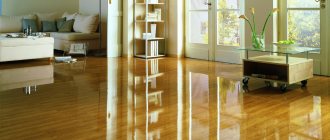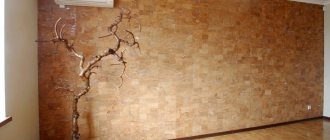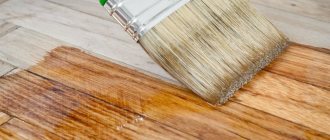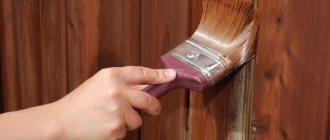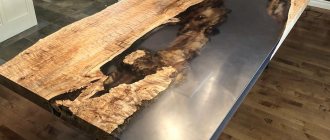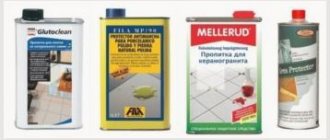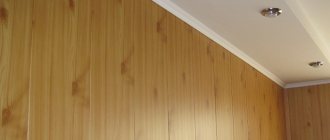Is it possible to glue wallpaper onto MDF wall panels?
Thus, MDF panels do not contain “chemicals” such as resin, glue, etc. Important! ... Modern production technology creates light and porous boards with good density, which makes it possible to glue wallpaper or even textiles onto similar MDF panels.
Interesting materials:
Where did the Russian people come from? What are the benefits of push-ups? Palpay how to use? The taskbar has moved to the right, how can I move it back down? Karcher steam cleaner how to use? What is a steam station? What benefits does the elbow plank give? How long should you hold the plank? Plank how many approaches? Plank how much?
Advantages of varnishing
The varnish can ruin the coating of the panels (corrodes it). However, when applied carefully, this finishing method has several advantages:
- increasing the strength of particle boards, MDF becomes resistant to mechanical loads, and the likelihood of damage due to impacts is reduced;
- resistance to temperature influences increases, MDF does not lose its shape when the value of this parameter increases, thanks to this it becomes possible to place hot dishes on the surface of chipboards;
- varnish improves the external properties of the panels; there are compositions that allow you to obtain a glossy surface, pearlescent, matte and other types of materials;
- used for finishing surfaces inside and outside the object;
- the ability to maintain its original shape under the influence of moisture is retained, the panels do not swell;
- resistance to fungi;
- provides protection against chemicals;
- the varnished surface is easy to clean, partly due to the increased moisture resistance of the panels.
As a result, the service life of particle boards increases. They can be installed even for operation in difficult conditions: under the influence of high temperatures, with increasing humidity.
How to apply moisture impregnation to plywood?
- Process elements that are already prepared for installation (cut exactly to size).
- Drying oil, varnish, paint, oil are applied with a soft brush with fine bristles or a roller. You can use a spray bottle.
- It is necessary to apply impregnation to plywood only along the fibers.
- Sheets must be in a horizontal position.
- Each layer should dry for at least 10-12 hours.
- If residues form during the application process, remove them with a soft cloth.
- The sheets are primed and painted on both sides.
Compliance with coating technology will allow you to obtain a product that will serve you for many years without changing its appearance or physical properties.
Dyeing technology
The final result of processing MDF depends on whether the sequence of actions was followed when applying the composition. Main stages:
- putty;
- primer;
- direct painting with varnish;
- drying.
First, the room and surfaces to be treated are prepared. Floors, walls and pieces of furniture located next to the surface to be treated are protected from varnish splashes. It will be difficult to remove such defects in the future. If you use a solvent for this, you can damage the furniture or the lining of the floor or supporting structures.
Please note: Reasons for applying varnish to acrylic paint
At the next stage, the surface that will be varnished is sanded. For this purpose, abrasive means for mechanical grinding or electrical equipment are used to speed up the process. The MDF surface is smooth. If you apply finishing material to an unprepared slab, the service life of the decorative coating will be reduced. To prolong it, abrasive agents are used.
In this case, they are not used to increase the smoothness of the surface, but, on the contrary, make it rough. The risks are small in size, so they do not degrade the appearance of the product.
Grinding
The following agents help increase adhesion:
- sandpaper, used for dry sanding;
- scotch-brite;
- Grinder.
Small panels are treated with sandpaper or Scotch Brite. The first of the products differs in the degree of granularity. Large surfaces are sanded with 700 series mats, which are characterized by fine-grained abrasives. To process compact MDF products, use sandpaper P220-P280.
The grinder operates quickly and more efficiently, while the work takes a minimum amount of time. Scotch Brite is an abrasive material, it is non-woven, and its properties resemble felt.
putty
After grinding, the surface is degreased; for this purpose, Antisilicone is often used. Large defects are eliminated with putty. Such compositions allow you to remove cracks, leaks, and dents. After the marks have formed, the putty will adhere well to the smooth MDF surface.
Antisilicone is used after puttying.
Considering that this material contains wood chips, it is recommended to use only a special composition. A suitable option is acrylic putty for wood. A rubber spatula is used for application.
Primer
For MDF chipboards, a polyurethane composition is considered the most suitable option. It is distinguished from analogues by a significant proportion of resins. As a result, the likelihood of shrinkage of the material layer is reduced.
If you plan to use glossy varnish in the future, it is recommended to choose a polyester primer; it hides minor surface defects better. One layer is enough. If necessary, the next layer is applied when the previous one has dried. Then they move on to the next stage.
Painting
Recommended environmental parameters:
- air humidity – no higher than 80%;
- temperature – up to +20°С.
Pay attention to: Applying varnish to decorative plaster: types, advantages, technology for working with the composition.
Varnishing is done with a spray gun, brush or roller. The solution, like the primer, is mixed with a hardener or thinner. The ratio of components varies depending on what composition is used:
- matte varnish: 100 parts by weight of enamel, 50 parts of hardener, 30 parts of thinner;
- glossy: only the amount of hardener changes - 70 parts.
The recommended consumption of such material is 150 g/m². The composition will harden after 1 day, the polymerization process will be completely completed after 3 days.
Wet technology
In this case, liquid formulations are used. They are applied using a spray gun, the varnish comes out of a minimal hole under pressure. This results in the formation of small droplets. As a result, the surface is covered with a uniform layer. The likelihood of smudges is low, since the maximum layer thickness is 120 microns. When using this method, defects become more pronounced, especially if small debris remains on the surface.
Application of wet technology.
Powder technology
This coloring method is not used in everyday life, since special equipment is required. It is based on a dry powder composition. It is applied under pressure using a spray gun, then the particles need to be melted. To do this, the product is exposed to high temperatures.
The strength of the coating will be the highest, since the particles penetrate into the structure of the material under the influence of pressure. It is difficult to remove such a layer of paint.
Varnishing
The procedure is performed according to the instructions:
- The varnish is prepared for use.
- The first layer is applied at the rate of about 150 grams per square meter.
- After waiting for the first layer to dry well, apply a new layer.
- Repeat the drying process.
- Final sanding begins. First, sandpaper with a coarse grain is passed over the surface, then a finer one is used. To avoid lumps forming, spray the area with water.
- The panel is left for several days (from 4 to 7) and polished. For this it is better to use a power tool.
There are many tips on how to properly paint MDF. The main thing is to follow a clear plan and be careful.
The corridor is lined with MDF panels in a light wood look from floor to ceiling. The thickness of the panels is about 5 mm, I don’t see any film on top, it looks like a regular paper and cardboard layer on top. We touched it a little with our hands, decided to wash it with a damp dish sponge, rubbed it here and there a dozen times and rubbed it until there was a light spot in the middle of the wall, it would be okay if I stopped, otherwise I rubbed it in a couple more places. The first thought was to cover the entire corridor with stain or varnish, maybe darken it a little color, it doesn't matter. I'm leaning towards painting with a roller. What can you guys use to paint over worn areas and preserve the overall color if possible? Maybe varnish with a tint. Is it possible to cover MDF with it? I don’t understand how I did this. Thanks for the advice and Happy New Year everyone.
What should I use to protect it from moisture?
Dear meeting, please don’t kick me too hard for asking this question. I decided to make myself an audio system. Small speakers for this system will be round in cross-section. I've been looking for something to make them out of for a long time. But yesterday I caught my eye on a cardboard tube on which linoleum is wrapped. Its outer and inner diameters, as well as the wall thickness, turned out to be just right for the speakers. But here's a question. Since the pipe is made of cardboard, over time it will begin to swell from moisture. So I decided to find out from you what can be used to impregnate this cardboard tube in order to protect it from the harmful effects of moisture? I’ll just make a reservation right away. After impregnation, the pipe will be primed, painted and possibly varnished. But impregnation is needed for protection.
loosen the varnish (oil type) with a 1 to 1 solvent. Do not skimp on white spirit, it will still erode. paint 5 layers, drying per day. You won't be able to shoot the shell out of a cannon.
The primer is latex, penetrating, IMHO, that’s it.
Serjant, will this composition penetrate through these trimmings? Personally, I would like to soak through.
No matter what you soak it in, it will still turn out to be a barn floor. Cardboard is garbage for speakers. We need a tree.
sany_74 the role of these speakers will be rather decorative. I almost always wear TDS-6 Stereo headphones, still made in the Soviet Union, due to an agreement with my wife.
Why soak from the inside or through? Will they be in the bathroom? For me, the inner layer of cardboard will be an excellent vibroacoustic damper for sound, which is + for speakers. It is enough to cover the outside in any convenient way. And if you really want to, IMHO any wood impregnation based on, for example, alkyd varnish or polymerizing oil will do.
quote: Originally posted by sany_74: No matter what you soak it in, it will still turn out to be a threshing floor. Cardboard is garbage for speakers. We need a tree.
quote: Originally posted by sixfinger: For me, the inner layer of cardboard will be an excellent vibroacoustic damper for sound, which is + for speakers.
quote: No matter what you soak it in, it will still turn out to be a barn floor. Cardboard is garbage for speakers. We need a tree.
People, can I ask ALL OF YOU not to swear, but simply to give detailed answers and advice on the topic of the question?
If you are going to prime it and paint it, why else would impregnation of it be done behind the scenes?
quote: Originally posted by bambr22: if you prime and paint it, why else would impregnation of it be done behind the scenes.
Yes, it’s superfluous if the environment is such that the pressed cardboard gets wet, then the speaker will be covered sooner.
At work they gave this advice: Dissolve epoxy without hardener in alcohol until it becomes water, then add hardener and saturate the pipe with this mixture. The alcohol evaporates, and the epoxy hardens and the result is an absolutely solid pipe that is not afraid of moisture.
Well, most likely, acoustically it will be a piece of plastic. It's easier to take a sewer pipe.
To preserve the arton, the trap + epoxy bottom is also in several layers.
So maybe coat it with cyanoacrylate?
So, as the sergeant said, remove the varnish. Just not 1:1, but stronger and throw this cylinder into the solution. It will be soaked through in half an hour or an hour, and dry within a day. A couple or three of such cycles and there will be some kind of getinax. Just how it will sound - idk.
The working process
Before you start varnishing MDF structures, you need to prepare tools and additional materials:
- Tassels. You will need 2 pieces. One (narrow), with which you can paint small parts, and the second (medium) - for painting the remaining parts. An alternative is a roller or spray gun.
- Container for mixing components.
- A drill with a special attachment or a construction mixer.
- Working capacity.
- If there is a need to apply a design or ornament on the door, you need to prepare tape, stencils and a sponge.
- Sandpaper.
- Gloves.
- Solvent.
It is advisable to cover the workplace with paper and prepare a stable stand for the doors in advance.
Operating procedure
Before varnishing, you need to apply a layer of primer. For what? Firstly, the primer finally cleans the surface of dust and small debris. Secondly, it helps to avoid unnecessary consumption of the working mixture. Thirdly, it improves the absorbent properties of the material. And, fourthly, it makes it possible to make the coloring more uniform. Also, thanks to the primer, minor damage to the door leaf can be detected.
Paint application instructions
Before starting work, clean the surfaces again from dust, carefully wipe all parts and furniture cabinet doors with a degreaser. It is acceptable to use a brush for painting, but the process will be more difficult and longer. It's better to use a spray gun. Stages of work:
- First, the paint material itself is prepared, following the manufacturer’s recommendations.
- Paint is poured into a special compartment of the spray gun, and the settings are set so that the spray area is not large.
- You should start painting from hard-to-reach places, then move on to the main part.
- It is advisable to cover the item in several layers, waiting 20 minutes between each layer for drying.
If a beginner is working with a spray bottle, then the first application is done on an unnecessary surface in order to practice.
It is recommended to apply varnish to the dried item; it will give a glossy finish. In this case, they monitor the cleanliness of the room. The work is carried out similarly to painting, but the layers are applied at intervals of ten minutes. Polishing completes the work.
It is advisable to cover the item in several layers, waiting 20 minutes between each layer for drying.
The article described how to properly paint MDF panels; the process takes a lot of time. And it requires attentiveness from the master. When you decide to carry out the process yourself, it is advisable to carry out a test painting of old objects, then you can learn the basic principles. After all, the work is labor-intensive, and spoiling an expensive furniture set will not be very pleasant. If everything is done correctly, the result will be a beautiful and bright item that will look like new.
What varnish should be used for MDF boards
Consider options that provide different effects:
- matte;
- glossy.
The first of the materials includes acrylic components. Gloss varnish contains synthetic resins. It is recommended to coat MDF with two-component compounds. They are produced in separate containers. The substances are mixed before use. The result is a material characterized by suitable properties. They are used to varnish panels, but it is important to complete the work within the next 2-3 hours after preparing the solution. After this, the material loses its properties.
When choosing a varnish, a number of criteria are taken into account:
- recommended consumption – no more than 500 g per 1 m² (when applying 1 layer);
- concentration of volatile components in the composition – up to 20%;
- application conditions: +5…+25°С;
- the setting period of the composition is up to 15 minutes;
- Drying time: no more than 72 hours.
Pay attention to: Varnish for pine stairs: properties and application technology
Yacht varnish is suitable for protecting MDF. There are several varieties of it. They differ in the degree of toxicity, which determines the possibility of using such materials inside the facility. For example, the alkyd composition is highly toxic, so it is not used to treat walls or furniture in the house. It is permissible to use alkyd urethane inside the object. This composition has properties that are important when processing particle boards.
The alkyd-urethane analogue, on the contrary, contains more volatile toxic components. This yacht varnish cannot be used inside the house. Acrylate does not protect against water exposure well enough, but it is environmentally friendly, so it is used inside objects.
